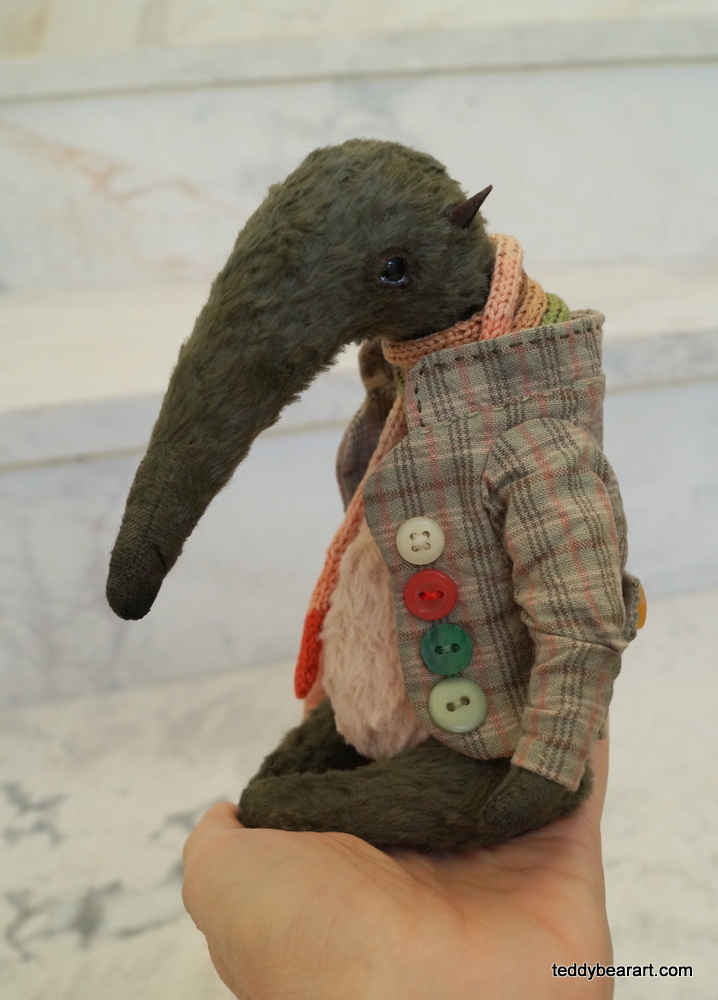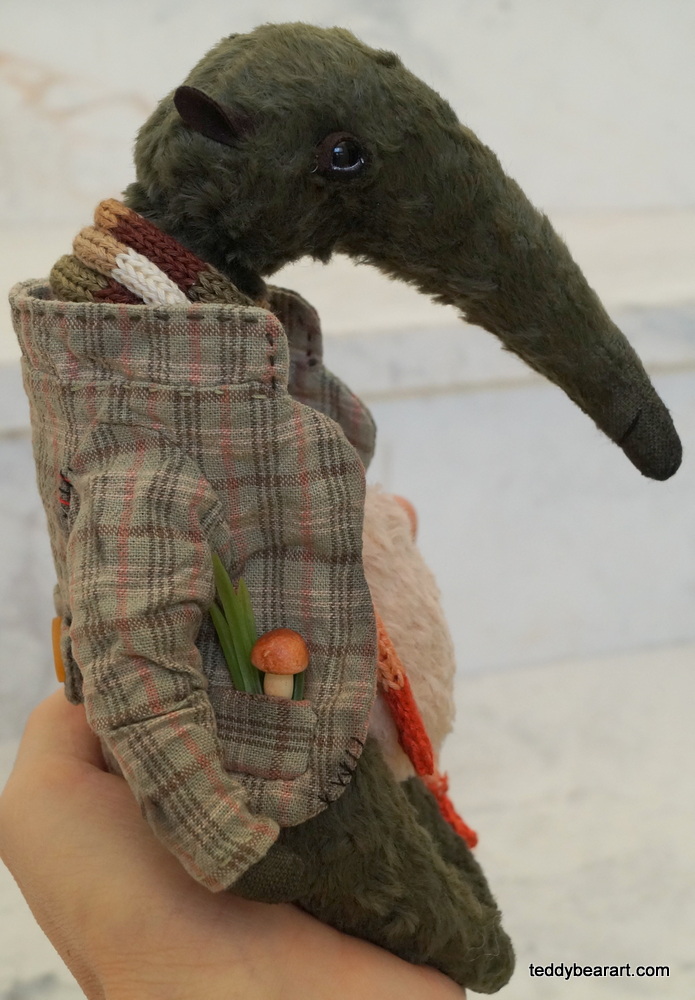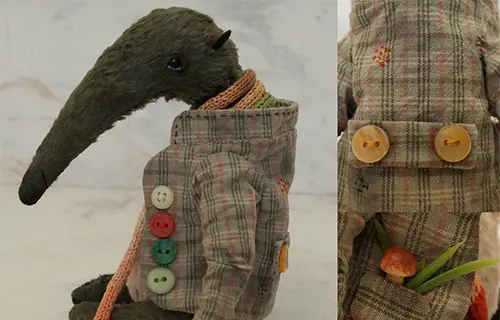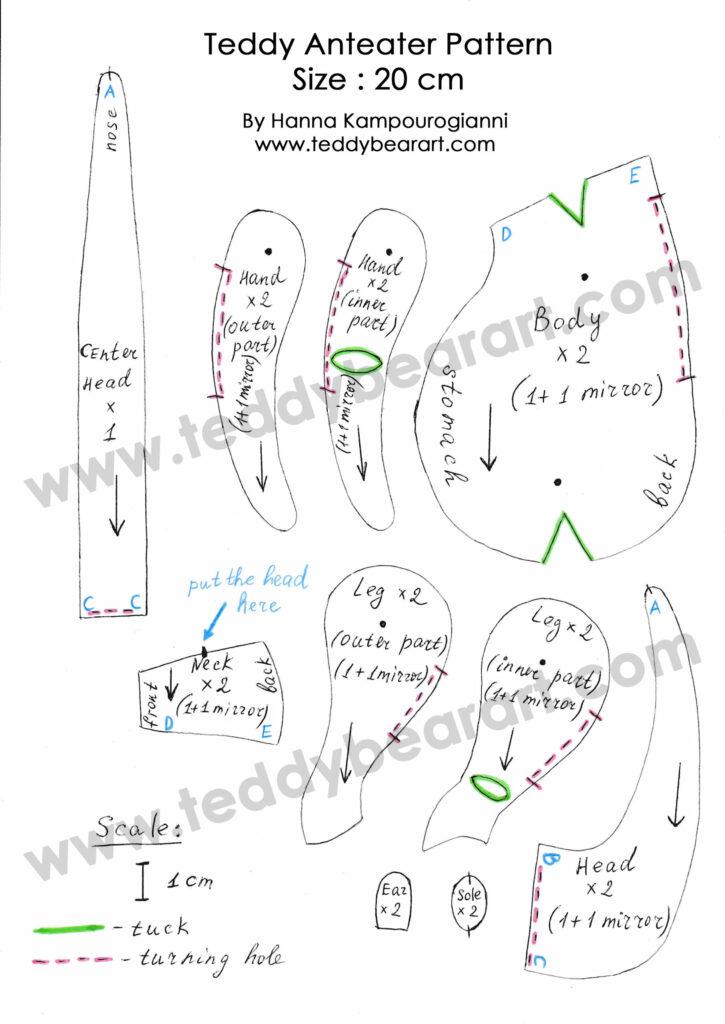Seeking a distinctive teddy bear project? In this article, we share a teddy bear pattern tutorial – Anteater in a Jacket. This step-by-step guide includes a full list of materials, sewing instructions, and tips for assembling and finishing the teddy anteater. The character was created by us and has already become a favorite among teddy bear collectors worldwide.

Download the Pattern
Notice that seam allowances are not included.
To download the pattern, follow the instructions below:
From a phone or tablet: There should be a similar option for mobile devices with Android or iOS. Click on the image. Save it by holding your finger on the image and selecting the “Save Image” option. Then, go to your photo gallery and print it (an option available).
From a computer: Click on the photo of the pattern you see below. In the new tab that will open, you press the right mouse button and select the “Save image as …” option. Then, you choose where the image will be saved on your computer.
If you are going to make your first teddy bear, we would recommend reading our posts about basic sewing and the step-by-step tutorial “How To Make A Teddy Bear”.
List of Required Materials
This pattern works best with short-pile fabrics such as viscose (6 mm pile length) or mohair. We recommend glass eyes, synthetic filler, and small accessories for realistic details.
For the ears, choose leather, suede, or felt. For the soles, cotton fabric works well.
List of Required Materials
1. 1/16 piece (25×35 cm) of viscose with a fur length of 6 mm.
2. Strong threads, the same color as your fabric, and a needle for hand sewing.
3. Scissors for cutting fabrics.
4. A pair of black glass eyes on a metal loop – 6 mm in diameter.
5. Waxed thread.
6. An awl.
7. Synthetic filler.
8. Metal or glass pellets for weight.
9. Fabric for the ears and feet.
10. Oil paints and brushes.
11. Pins.
12. Discs 20 mm diameter – 6 pieces. Discs 15 mm diameter – 4 pieces.
13. Washers 12 mm diameter – 10 pieces.
14. T-shaped cotter pins 1,6×20 – 5 pieces.
15. Pliers.
16. A long needle for attaching the eyes.
The discs for his legs and the head should be 20 mm in diameter. The discs for his hands should be 15 mm in diameter.
Step-By-Step Pattern Tutorial
When printing, check the scale indicated on the pattern. Arrange fabric pieces according to the arrows, leaving 5–7 mm seam allowance.
Preparation:
If using viscose, pluck a little pile on the nose, sides of the head, and tips of arms and legs before sewing. This gives a neater look. Cutting the pile after sewing often leaves fibers in the seams.
Step 1: Sew all darts (marked in green).
Step 2: Sew the two sides of the head (1 + 1 mirror) from A to B.
Step 3: Attach the central head wedge to the sides from A to C, leaving the red-dotted opening unsewn.
Step 4: Sew the neck to the body from D to D and E to E. Repeat for the mirrored parts.
Step 5: Join the body pieces, leaving the red-dotted opening unsewn.
Step 6: Sew outer and inner arms (1 + 1 mirror), leaving the red-dotted opening unsewn.
Step 7: Sew outer and inner legs (1 + 1 mirror), leaving the red-dotted opening unsewn.
Step 8: Sew on the feet.
Making the Teddy Anteater
Assemble the body, add pellets for weight, stuff, and sew up the final opening.
Turn the finished parts right-side out with a blunt wooden stick.
Stuff the head firmly with filler, insert the disc with a cotter pin, and secure with waxed thread.
Attach the glass eyes:
Make holes with an awl.
Thread the waxed thread through the eye loop and pull both ends through a long needle.
Insert and secure with pliers, then hide threads.
Optional: glue on eyelids from felt or suede.
Sew on the ears.
Attach the head to the body with the cotter pin.
Insert discs with cotter pins into the limbs, stuff them, and sew up the openings.
Final Touches
- Use an awl or needle to pull the pile from seams. Comb the toy with a metal brush.
- Tint areas around the nose, eyes, ears, and limbs using pastels, oil paints, or fabric paints. Always shade from light to dark.
- Let the toy dry completely, then embroider the mouth with black thread.
Your teddy anteater is ready!

Frequently Asked Questions (FAQ)
1. Do I need a sewing machine to make the teddy anteater?
No, all parts can be sewn by hand. A sewing machine is not required.
2. How long does it take to sew the teddy anteater?
On average, it takes about 1–2 days to complete, depending on your experience.
3. What size will the finished anteater be?
The finished toy will be about 20 cm tall (this may vary slightly depending on stuffing).
4. Can I use mohair instead of viscose?
Yes, the pattern works well with mohair, especially short-pile mohair.
5. How do I give the anteater a more vintage look?
You can lightly tone it with oil paints or pastels, and add small vintage-style accessories.
Before You Go
We hope this teddy bear pattern tutorial – Anteater inspires you to create your own unique character. Making teddy bears is a wonderful hobby that combines creativity, patience, and joy.
If you have any questions or need help during the process, feel free to leave a comment below, and we will be happy to assist you.
And if you’d like to add even more charm to your anteater, try sewing a jacket for him — it’s a simple project that makes the toy look truly special. [Link here]
Get Free Patterns & Be the First to Know!
Want free teddy bear patterns, exclusive tutorials, and a chance to win craft supplies?
Sign up for our newsletter using the subscribe form in the middle of this article to receive new patterns, insider tips, and the latest news on teddy bear art. You’ll also automatically be entered into our annual giveaway for a chance to win teddy bear crafting materials.
Bonus entry: Save one of our pins on Pinterest to increase your chances of winning!
Let’s create, inspire, and craft beautiful teddy bears together!



Hello..I am not able to access the Anteater coat step by step ..
would you be able to send it to me..kind regards Diana
pippicat53@hotmail.com email
Hello Diana,
Copy this link and search it on Google https://teddybearart.com/free-teddy-bear-sewing-pattern-anteater-in-a-jacket
All the information is there, I have no more. Please read it and follow the instructions below to download the pattern:
From a computer (Windows).
Click on the photo of the pattern you see below. In the new tab that will open, you press the right mouse button and select the “Save image as …” option. Then you choose where you want the image to be saved on your computer.
From a phone or a tablet (Android). There should be something similar for mobile devices with Android or iOS.
Click on the image. Save it by holding your finger on the image and selecting the “Save Image” option. Then go to your photo gallery and print it (there is an option).
Let me know if you manage to get it please.